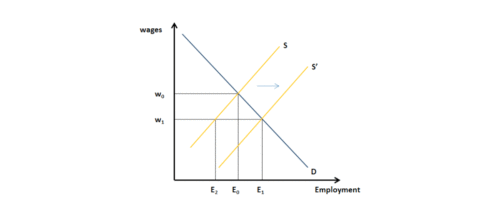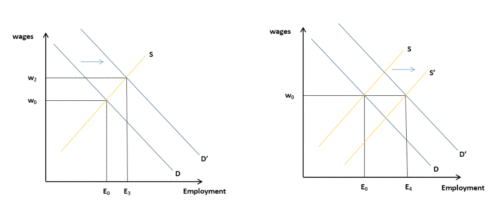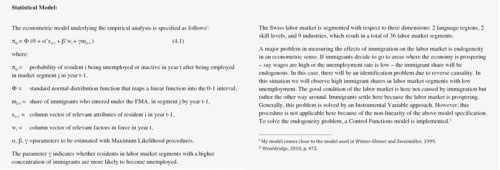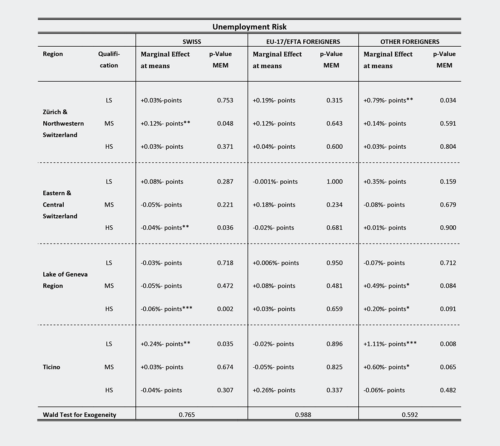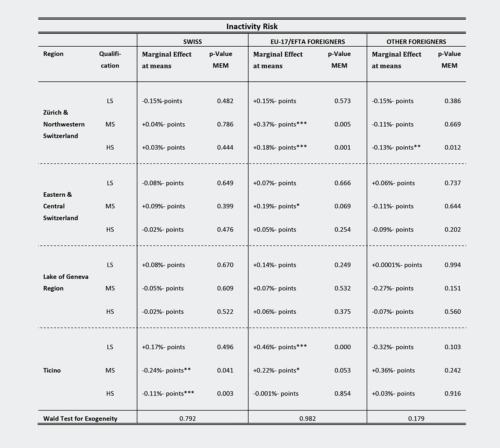highlights #1.4
Did the Free Movement Agreement with the EU Lead to Displacements in the Swiss Labor Market?

Ensar Can
Labor Economics and Industrial Organization, University of Basel
Switzerland attracted a lot of international attention when Swiss voters adopted the mass immigration initiative, which aims to revoke the Free Movement Agreement with the European Union and re-introduce immigration quotas. One important reason for adopting the initiative was the fear that immigrants take away residents’ jobs. This article investigates, by analyzing the relationship between displacement risk and share of immigrants in different labor market segments, whether this fear is justified.
From the enactment of the Free Movement Agreement (FMA) in 2002, to 2012, the foreign labor force grew by a third. Net migration from the European Union was on average around 40,000 per year in this period. One important characteristic of this new migration is the skill mix of the immigrant workforce. While half of the immigrants from 1960 on to the early 1990s were low skilled, more than 50% of the new migrants possessed an academic diploma when they came to Switzerland. Against this backdrop, the following measures the relationship between the new immigration to Switzerland and its impact on the unemployment of the resident workforce.
The Limitations of Theoretical Approaches
The impact of immigration on the labor market is affected by many different factors such as the skill mix of the migrants, capital adjustments, international trade, wage rigidity, and different forms of immigration. I focus here on the latter aspect, which is important to understand the Swiss case.(1) In this context, I distinguish between two forms of immigration: the exogenous and the endogenous case. Immigration is exogenous, if it occurs independently of the local labor market conditions. In such a case, immigration may be caused by war, poverty, political instability or other factors related to the sending countries. Given this assumption, the decision to migrate is taken with the intention of settling in the host country permanently. This form of immigration is mostly observed in traditional immigrant destination countries such as the United States, Australia, or Canada. The influx leads to an exogenous increase in labor supply. In such a situation, the labor market has to absorb the new workers. In the case of endogenous immigration, however, the local labor market induces the influx. It is a consequence of an unmet rise in the demand for labor in the host country. This may have several reasons such as, for example, labor shortage caused by demographic change.
“Immigration is exogenous, if it occurs independent from the local labor market conditions. Endogenous immigration, however, is a consequence of a rise in the demand for labor in the host country.”
The effects of these two forms of immigration can be shown by looking at a classical labor market model. The setup of such a model may be rudimentary, implying a number of assumptions; however, the model provides good insights, when it comes to the results of immigration.
Figure 1 illustrates the labor market with the supply curve S, which is increasing and the demand curve D, which is decreasing with higher wage levels. The labor market is initially in equilibrium with wage w0 and employment E0. Exogenous immigration leads to a higher labor supply which is reflected in a shift in the supply curve from S to S’. Increased competition decreases the wage from w0 to w1 and raises total employment from E0 to E1 until a new equilibrium is reached. This results in a decrease in the employment of the resident workforce from E0 to E2. In such a case, resident workers are crowded out by immigrants, represented in the graph by the distance between E1 and E2. The magnitude of this crowding-out effect depends on wage rigidities and elasticities.
In contrast to the exogenous case, endogenous immigration occurs in reaction to an excess demand for labor in the host country. Immigrants often come with the intention to work and then return to their home countries. Looking again at the classical labor market model shows that, in this case, demand first increases to D’ creating a disequilibrium (left-hand panel in Figure 2). Absent immigration, wages first rise from w0 to w2, and employment increase from E0 to E3.
The right-hand panel in Figure 2 models the endogenous immigration as a reaction to the new situation. The immigration shown in the figure corresponds exactly to the shift in the demand curve. In such a situation, wages and resident employment remain at w0 and E0. The difference between the new employment equilibrium E4 and the initial equilibrium E0 represents the number of immigrants employed in the labor market. The immigrants and residents do not compete for the same jobs. Wage and employment structures remain unchanged.
Nevertheless, it is possible that immigration is curbed by quotas and, thus, cannot completely cover the excess labor demand. This situation would lead to a slight rise in wages and employment. In this case, immigration prevents wages from rising strongly but only meets part of the increased labor demand. The opposite situation is an influx of more immigrants than needed. Such a situation with excess immigration may lead to negative outcomes in the host country’s labor market.
In short, exogenous immigration is likely to lead to a wage drop and negative employment effects. Endogenous immigration, on the other hand, is likely to satisfy the host country’s excess labor demand and prevent wages from rising strongly and production shortages to arise.
“While exogenous immigration disturbs the labor market equilibrium, the endogenous case closes a disequilibrium gap.”
Nevertheless, we see that even in the endogenous case, situations can arise where immigration has an adverse impact on wages and resident employment.
How to Measure the Impact of Immigration
Since theory cannot provide a clear answer to the question on the impacts of migration, the effects have to be measured using real world data. For this purpose, two approaches exist in the literature – namely, the structural and the direct approach.(2) I use here the direct approach, which segments the labor market into cells and correlates the variation in immigrant shares with the labor market outcomes of residents.(3) This approach has several advantages against the structural approach, which simulates the impact of migration using a production function. First, if the production function is not correctly specified, it may produce biased results. Another major problem is its applicability to the Swiss case. The structural model cannot take endogenous immigration into account, since it implicitly assumes immigration to be exogenous. Given that there is strong evidence that immigration in Switzerland is endogenous, this model is less appropriate for the Swiss case.(4)
The variable of interest in my econometric model is dichotomous and takes the value 1 if a person is employed in t-1 and becomes unemployed or inactive in t, and zero otherwise. The dependent variable indicates the probability of becoming unemployed or inactive. I call that the unemployed or inactivity risk.
I measure the impact of migration on different regions and skill-levels. Accordingly, the Swiss labor market is broken down into the four regions (Zurich and Northwest Switzerland, East and Central Switzerland, the Lake of Geneva region and the canton of Ticino) and three skill-levels (low, medium and high-skilled workers). A more detailed segmentation would lead to fewer observations, which would make it hard to establish any effects.
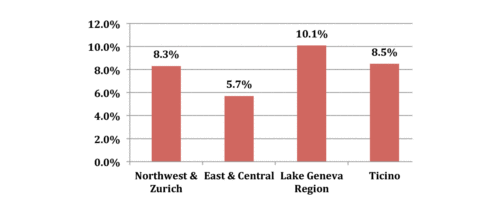
Figure 3: Share of EU-Migrants Immigrated under the Frame of the FMA in the Employed Population in Switzerland in 2011; Source: Swiss Labor Force Survey, own calculations
Northwest Switzerland and Zurich as well as the Lake Geneva region are more urban areas with a big industrial and service sector. In contrast to the rural regions of Central and East Switzerland, these areas receive more immigrants. The canton of Ticino is taken as a separate region because it differs from the other regions with respect to the composition of its immigrants.
The estimations are carried out for three different resident groups, as they differ significantly in their characteristics: (i) Swiss, (ii) EU foreigners who immigrated before the FMA, and (iii) other foreigners from third countries.
For the estimations, the Swiss Labor Force Survey (SLFS) from 2002 to 2011 is used. This survey has been conducted since 1991 and delivers a representative sample of the population above the age of 15. The SLSF consists of panel data that were drawn annually from survey interviews with individuals. This data consists of 530,000 observations between 2002 and 2011. They allow us to identify FMA immigrants by simply looking at the current duration of stay in Switzerland and the country of origin. For the estimations, only persons between 15 and 60 years of age are included. The age is limited to 60 so as to avoid any biases due to early retirement. Individuals with temporary work contracts are also dropped. Extreme and implausible observations are eliminated. Further only the first two survey waves are considered to avoid panel attrition. Our resulting estimation data consists of 150,000 observations.
Did the Immigration Lead to a Higher Displacement Risk for Residents?
I find scant evidence of an impact of the immigration on the employment outcomes of the resident workforce. At the national level, no statistically significant effects can be established, whereas at the level of regions and skills, only few examined cases are significant. These statically significant cases show that the high-skilled resident workforce profits, while the low-skilled workforce loses out.
The high-skilled Swiss enjoy a decrease in their unemployment risk in two out of four regions. The medium-skilled in Zurich and Northwest Switzerland as well as the low-skilled in the Ticino suffered slightly higher levels of unemployment risk. Low and medium skilled other foreigners each suffered in two of the regions. In the Lake of Geneva region, high-skilled other foreigners face a higher unemployment risk, which could be caused by excess immigration in to this labor market segment.
Former EU migrants did not suffer from displacement risk, though they were the group with the largest increase in inactivity risk. They faced a higher inactivity risk in five out of twelve cases, whereas no positive effects could be observed for them. On the other hand, medium and high-skilled Swiss in the Ticino and high-skilled other foreigners in Zurich and Northwest profited in terms of inactivity risk.
These results indicate that the new migration to Switzerland is mainly driven by endogenous factors. Immigration of high-skilled persons seems to cover the excess demand that exists in the labor market for qualified workers. Such a situation cannot be observed in the market for the low-skilled. Thus, the immigration of the low-skilled workforce leads to higher competition and crowding out.
“I conclude from this that the immigrants act as complements for the high-skilled labor and as substitutes to the low-skilled labor.”
Other studies conducted for Switzerland come to similar results. Most studies, which try to quantify the impact of immigration on labor market, find no or very small effects. This is true for the wages(5), as well as for the employment opportunities of the residents.(6)
“The labor market was barely affected by immigration. The empirical evidence speaks clearly in favor of a mainly endogenous immigration, which is driven by labor shortages in Switzerland.”
Even though the economy profits in total, one has to bear in mind that there are also losers from immigration. Since the amount of low-skilled labor immigration stayed quite low in the last decade, the negative effects are rather small.
—
(1) Can et al. ,2013.
(2) An overview is given by Okkerse ,2008; Blau and Kahn, 2012.
(3) This is a more general notation of the Area Analysis or Spatial Correlations Approach.
(4) Survey by the UBS (2012) with a sample of Swiss firms shows that the central reason for hiring immigrants is a specific labor scarcity in the resident workforce.
(5) Sheldon, 2003; Küng, 2005; Gerfin and Kaiser, 2010; Cueni and Sheldon, 2011; Favre, 2012; Müller et al., 2013.
(6) Favre et al., 2013; Basten and Siegenthaler, 2014; Beerli and Peri, 2015.
References
Basten, Christoph, and Michael Siegenthaler. “Do Immigrants Take or Create Residents’ Jobs? Quasi-Experimental Evidence from Switzerland.” KOF Working Papers No. 335 (2013).
Beerli, Andreas, and Giovanni Peri. “The Labour Market Effects of Opening the Border: New Evidence from Switzerland.” NBER Working Paper 21319 (2015).
Blau, Francine D., and Lawrence M. Kahn. “Immigration and the Distribution of Incomes.” NBER Working Paper 18515 (2012).
Can, Ensar, Nathalie Ramel, and George Sheldon. Effekte der Personenfreizügigkeit auf die wirtschaftliche Entwicklung der Schweiz. Studie erstellt im Auftrag des Schweizerischen Arbeitgeberverbands. Zürich, 2013.
Cueni, Dominique, and George Sheldon. “Die Auswirkung der Personenfreizügigkeit der Schweiz mit der EU auf die Löhne einheimischer Arbeitskräfte.” WWZ Forschungsbericht 2011/05 (2011).
Favre, Sandro. “The Impact of Immigration on the Wage Distribution in Switzerland.” NRN Working Paper 1108/2011. University of Linz and University of Zurich, 2012.
Favre, Sandro, Rafael Lalive, and Josef Zweimüller. “Verdrängungs-effekte des Freizügigkeitsabkommens Schweiz-EU auf dem Schweizer Arbeitsmarkt.” Studie im Auftrag des SECO. Bern, 2013.
Gerfin, Michael, and Boris Kaiser. „The Effects of Immigration on Wages: An Application of the Structural Skill-Cell Approach.” Diskussionsschriften dp 1012. University of Bern, 2010.
Küng, Lorenz. “The Impact of Immigration on Swiss Wages. A Fixed Effects Two Stage Least Squares Analysis.” mimeo. University of Fribourg, 2005.
Müller, Tobias, Noé Asensio, and Roman Graf. “Les effets de la libre circulation des personnes sur les salaires en Suisse.” Technical Report. Laboratoire d’économie appliqué and Observatoire universitaire de l’emploi, University of Geneva, 2013.
Okkerse, Liesbet. “How to Measure Labour Market Effects of Immigration. A Review.” Journal of Economic Surveys 22, no. 1 (2008): 1–30.
Sheldon, George. “Die Auswirkung der Ausländerbeschäftigung auf die Löhne und das Wirtschaftswachstum in der Schweiz. ” In Migration und die Schweiz, edited by Hans-Rudolf Wicker, Rosita Fibbi, and Werner Haug. 335–367. Zürich: Seismo Verlag, 2003.
UBS. UBS Lohnumfrage Schweiz – Ausblick. Zürich, 2012.
Winter-Ebmer, Rudolf, and Josef Zweimüller. “Do Immigrants Displace Young Native Workers: The Austrian Experience.” Journal of Population Economics Springer, 12, no. 2 (1999): 327–340.
Wooldridge, Jeffrey M. Econometric Analysis of Cross Section and Panel Data. Cambridge and London: The MIT Press, 2010.
Further Reading
Borjas, George J. “The Economic Analysis of Immigration.” In Handbook of Labor Economics, Vol. 3A, edited by Orley C. Ashenfelter and David Card. 1697–1760. Amsterdam: Elsevier Science, 1999.
Card, David. “Immigrant Inflows, Native Outflows, and the Local Market Impacts of Higher Immigration.” Journal of Labor Economics 19, no. 1 (2001): 22–64.
Dustmann, Christian, Francesca Fabbri, and Ian Preston. “The Impact of Immigration on the British Labour Market.” Economic Journal 115, no. 507 (2005): 324–341.
Glitz, Albrecht. “The Labor Market Impact of Immigration: A Quasi-Experiment Exploiting Immigrant Location Rules in Germany.” Journal of Labor Economics 30 (2012): 175–213.


